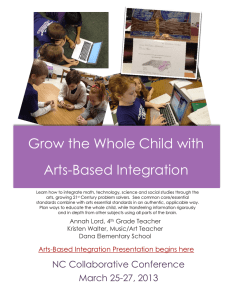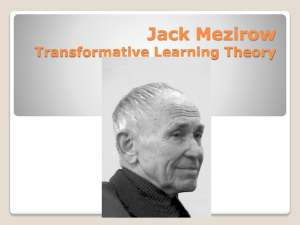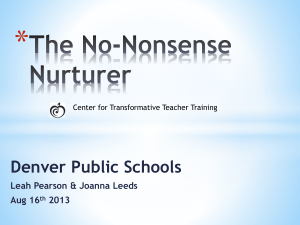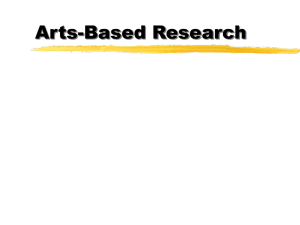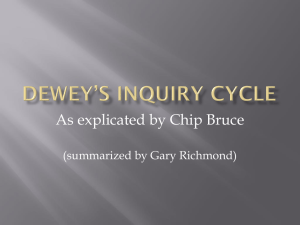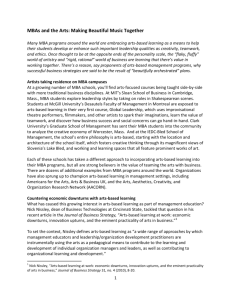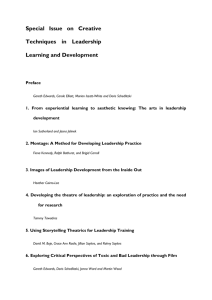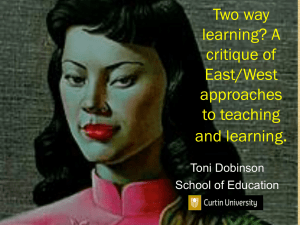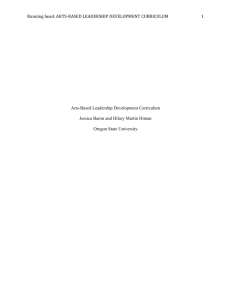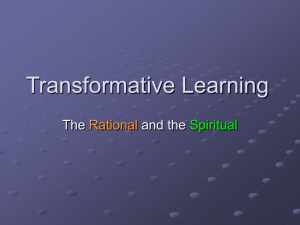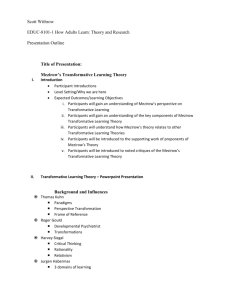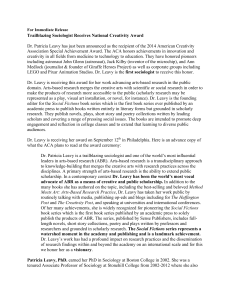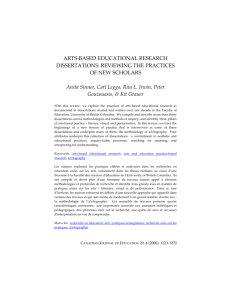Arts Based Inquiry Prof Digby Warren
advertisement
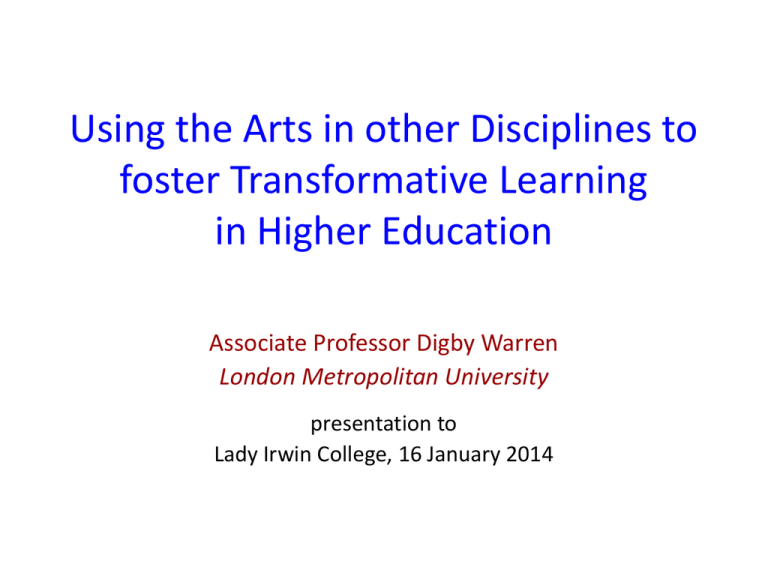
Using the Arts in other Disciplines to foster Transformative Learning in Higher Education Associate Professor Digby Warren London Metropolitan University presentation to Lady Irwin College, 16 January 2014 Arts-based Learning This approach has been called “Arts-based inquiry” – a term adopted from research literature by Louise Younie Definition: “student practical engagement with any art form – poetry, photography, painting, narrative, sculpture, dance, music etc. - as they reflect on their experiences” (Younie 2013, p.25) Art forms can stimulate “inquiry” in the sense of seeking to understand in a new and deeper way Arts-based Learning across Disciplines Examples • art / image-making – Medical education, Healthcare, Marketing, Child Care • video / photography – teacher education • film (cinema) – Economics • music-making – Leadership & Management • drama – Applied Ethics • poetry – Business, Healthcare • story-telling – Social Work, Healthcare • labyrinth – various disciplines (Dentistry, Law, MBA etc) See McIntosh & Warren (eds) (2013) Creativity in the Classroom: Case Studies in Using the Arts in Teaching and Learning in Higher Education Power of Creative Methods Arts-based methods use symbolic objects = multi-sensory, multi-faceted forms of expression, which can: • generate rich insights by unlocking unconscious ideas, feelings or memories • employ the power of metaphorical thinking at both theoretic (reasoning) and poetic (imagination) levels • foster student reflection, self-knowledge, creative thinking and metacognition (awareness of one’s thinking and learning processes) • enable “transformative learning” approaches concerned with whole person development Transformative Learning (TL) • Mezirow’s (1991) notion of “perspective transformation” = shift towards “more inclusive” perspectives (ways of seeing) as a result of critical reflection on our existing beliefs and assumptions; a rationalist model of TL • holistic notions of TL - “use of all the functions we have available for knowing, including our cognitive, affective, somatic, intuitive, and spiritual dimensions” (cited in Taylor 1997 p.49) = mind, heart, body and spirit all involved in coming to know/make sense of things • Barnett (2007) – urges that Higher Education should take seriously the student as a human being and learning as journey of engagement, passion, being and becoming Arts-based Inquiry • creative methods used as vehicles for exploration of and reflection on prior experience, e.g. – using a poem to think about patient care (doctors and nurses in training) and develop empathy • activities as direct forms of experiential learning, e.g. – learning about teamwork via collective music-making = metaphor for leadership (as “improvisation”) and teamwork (as “performance”) – reflecting on one’s life path or ‘script’ through telling stories based on professional experiences (e.g. child care workers) – walking a labyrinth = meditative space for reflection and creativity Arts-based Inquiry Challenges • metaphors can constrain ways of seeing – consider limitations of particular metaphors (where appropriate) • stories can be oppressive, if used to preach or control – ensure ethical, anti-discriminatory practice • students feeling blocked by lack of artistic skills or ‘internal critic’ - point of the exercise is engagement • initial anxiety or some potential resistance – clarify the purpose of tasks & allow students time to settle into them • uncovering of unconscious emotions, attitudes or beliefs can be cathartic but also mixed reactions – acknowledge the emotional, be available to talk privately to individuals Arts-based Inquiry Role of the lecturer • set clear boundaries and ground rules – safe space, rapport and trust • ‘leader and facilitator’, also ‘questioner, challenger, supporter, clarifier and explainer’ • authenticity – being open and honest inspires students to be the same • choose assessment methods appropriate to the nature of the learning in subject/course • clear guidance about assessment expectations and potential learning benefits of creative approaches Outcomes (from real case studies) deeper learning: • increased motivation, participation and enjoyment by students • “more democratic” interaction and more co-learning between students and teachers • enhanced confidence, resilience and self-belief • deeper reflection and creativity stimulated transformative learning: • deeper awareness of own values, aspirations, emotions and inert prejudices, and how to deal with them better in professional situations • more openness towards others and to alternative perspectives Arts-based Inquiry Assessment example: portfolio of “patch work” texts 1. Formative elements (“patches”) relevant to the subject matter/course and chosen by the student, e.g. • a short story or poem (written by the student) • an article or book review • visual reflection on a personal experience (drawing, collage, photograph) • application of a theory to professional practice • notes from a field trip or museum visit patches discussed with peers 2. Summative element: critical commentary “stitches” together the patches and draws on further (theoretical) reading to produce a synthesis which addresses the main aims of the module/course References Barnett, Ronald (2007) A Will to Learn: Being a Student in an Age of Uncertainty. Berkshire: Open University Press Mezirow, J. (1991). Transformative Dimensions of Adult Learning. San Francisco: Jossey-Bass Taylor, Edward W. (1997) Building on the theoretical debate: A critical review of the empirical studies of Mezirow’s transformative learning theory. Adult Education Quarterly, 48 (1), pp. 34-59 Younie, Louise (2013) Introducing Arts-based Inquiry into Medical Education: ‘Exploring the Creative Arts in Health and Illness’, in Paul McIntosh & Digby Warren (editors), Creativity in the Classroom: Case Studies in Using the Arts in Teaching and Learning in Higher Education. Bristol: Intellect, chapter 2
